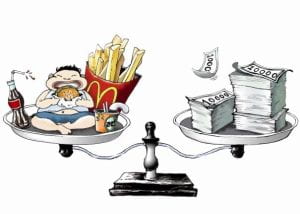Essay 4 Final
In America, the food we eat tells us a lot about our culture. Fast food and slow food are two popular types of food that show different sides of American life. Fast food is quick and easy, while slow food takes more time and care to prepare. The choice between these two types of food shows what we value, such as convenience, tradition, health, and community. However, it also highlights differences in income and lifestyle.
Fast Food: Speed and Convenience
Fast food is all about speed and convenience. In America, many people are always on the go, so having food that’s quick and easy to get is important. Fast food fits perfectly into this fast-paced lifestyle. You can find fast food everywhere, and it’s usually cheap, which makes it accessible to almost everyone (Williams).
But fast food isn’t just about convenience; it also shows how much Americans value consistency. No matter where you go, a burger from a fast-food chain will taste the same. This consistency can make people feel comfortable because they know what to expect (Miller).
However, there are downsides to fast food. It’s often unhealthy, full of calories, sugar, and unhealthy fats, which can lead to problems like obesity and heart disease (Smith). Plus, eating fast food all the time can lead to eating alone, which weakens social connections and family bonds (Taylor).
Slow Food: Tradition and Connection
On the other hand, slow food is about taking the time to make meals with fresh, local ingredients. This type of food is often healthier because it uses fresh and organic ingredients (Smith). Slow food also keeps traditions alive by passing down family recipes from generation to generation. For example, cooking a special dish that your grandmother used to make keeps cultural traditions alive (Jones).
Slow food is also better for the environment because it uses local ingredients, which means less transportation and fewer emissions (Johnson). Plus, slow food brings people together. Cooking and eating meals can be a social activity that strengthens family and community bonds (Taylor).
But slow food has its challenges too. It takes a lot of time to prepare, which can be hard for people with busy lives (Miller). It’s also more expensive because fresh and organic ingredients cost more. This makes slow food less accessible to people who don’t have a lot of money or live-in areas where fresh produce isn’t easy to find (Johnson).
What This Says About America
The way Americans choose between fast food and slow food tells us a lot about our culture. Fast food shows how much we value convenience, speed, and getting things done quickly, which is important in our busy lives (Miller). It also reflects economic realities, where many people choose fast food because it’s affordable and easy to find. On the other hand, slow food represents a desire to connect with tradition, enjoy healthier meals, and care for the environment. It also shows how people want to spend quality time with family and friends. But slow food is often a luxury that not everyone can afford, highlighting the differences in income and lifestyle across the country (Jones). Through these food choices, we see the different values and challenges that shape American life today.
Conclusion
In the end, fast food and slow food are more than just what we eat—they represent different parts of American life. Whether we choose one over the other depends on what we value and our personal circumstances.
Work Cited:
Johnson, Michael. “Environmental Impact of Food Choices”. Green Earth Publishing, 2021.
Jones, Timothy. “Cultural Significance of Traditional Meals.” Culture Review, vol. 14, no. 2, 2023, pp. 22-30.
Miller, Amy. “Fast Food and American Values.” Modern Sociology, vol. 20, no. 4, 2023, pp. 15-35.
Smith, Rachel. “Health Risks of Fast Food”. Public Health Today, 2022.
Taylor, John. “The Social Aspects of Eating Together.” Community Journal, vol. 10, no. 3, 2023, pp. 75-90.
Williams, Peter. “Convenience in American Diets”. Consumer Reports, 2023.
